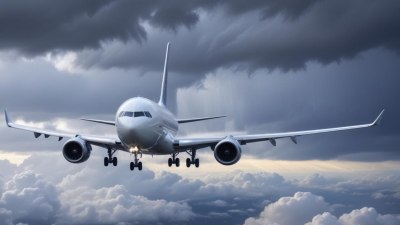How Weather Affects Airplane Flights
Explore the impact of weather on airplane flights including turbulence, delays, and safety.

This image was created with the assistance of Freepik
Weather plays a crucial role in the operation of airplane flights. From thunderstorms to snowstorms, various weather conditions can result in delays, cancellations, and even dangerous flying conditions. Understanding these factors can help both pilots and passengers navigate the skies safely.
Types of Weather Conditions
There are several types of weather phenomena that can impact flights. The primary ones include thunderstorms, wind, fog, ice, and temperature extremes.
Thunderstorms are perhaps the most notable weather hazard for flying. They create turbulent air, strong winds, and lightning. Pilots are trained to avoid flying through thunderstorms, often rerouting flights to avoid these cells. Severe thunderstorms can extend up to 60,000 feet into the atmosphere.
Wind and its Impacts
Wind can have various impacts on flights, especially strong winds and turbulence. Crosswinds can affect takeoff and landing, requiring pilots to adjust their approach. Additionally, headwinds can slow down flights, increasing flight time, while tailwinds can speed up a journey but also create challenges during landing.
Gusty winds can lead to unexpected turbulence, making for an uncomfortable flight. Pilots often rely on meteorological data to understand wind patterns along their routes and make necessary adjustments. It is not uncommon for pilots to receive updates on wind conditions during flights, which allows for real-time adjustments.
The Role of Fog
Fog is another weather condition that can significantly affect airplane flights. It reduces visibility, making it challenging for pilots to take off and land safely. In cases of dense fog, airports may implement ground delays until visibility improves. Aircraft rely on instrument landing systems (ILS) to land safely in low-visibility conditions, but there are limits based on how thick the fog is.
Air traffic control also plays a critical role during foggy conditions by managing arrivals and departures to maintain safety and efficiency. Delays are common when fog is prevalent, and passengers are generally advised to check for updates from their airline.
Ice and Snow Challenges
Winter weather can introduce a significant set of challenges for airlines, especially during periods of significant snowfall or icing. Snow can accumulate on runways, requiring snow removal before flights can operate. In addition, ice can form on aircraft wings and control surfaces, degrading aerodynamic performance.
Before flights can take off or land in snowy conditions, de-icing procedures must be performed. This process uses a mixture of antifreeze and heated fluid to remove ice and snow from the aircraft. Airlines must allocate additional time for this procedure, which can lead to flight delays during snowy weather.
Temperature Extremes
Temperature can affect aircraft operations, particularly extreme heat or cold. High temperatures can lead to reduced engine performance, affecting the aircraft's ability to take off. On particularly hot days, airlines may need to increase the required runway length during take-off to accommodate for decreased lift.
Conversely, cold temperatures also present challenges. Aircraft parts can become more susceptible to freezing, and ground equipment may struggle to function correctly in icy conditions. Pilots and ground crew must be prepared to deal with the effects of temperature to ensure a safe flight.
Turbulence Caused by Weather
Turbulence is a frequent occurrence in aviation, often influenced by weather. It can be caused by various factors, including thermal currents, jet streams, or turbulence around mountains. Weather-related turbulence can be categorized into several types, including clear air turbulence, which occurs at high altitudes in the absence of visible weather.
Clear air turbulence typically happens near jet streams and can catch pilots off guard, leading to sudden jolts in the cabin. It is critical for passengers to keep their seatbelts fastened when seated, even when the seatbelt sign is turned off, as turbulence can occur unexpectedly.
Weather Forecasting and Aviation
In modern aviation, weather forecasting has become an essential tool for flight operations. Airlines and pilots rely on accurate weather data to plan routes and ensure passenger safety. Meteorologists utilize advanced technology to predict weather patterns and provide real-time updates, which are crucial for flight safety and efficiency.
Air traffic control facilities receive weather information from various sources, including satellites, radar, and weather stations. This data helps controllers maintain safe distances between aircraft and avoid hazardous weather areas. Developing a detailed weather plan is a common practice for airlines, allowing them to anticipate challenges and make necessary adjustments.
Passenger Experience
For passengers, weather can significantly impact their travel experience. Delays or cancellations caused by adverse weather can lead to frustration and disrupted travel plans. Therefore, it is crucial for passengers to stay informed about potential weather issues that may affect their flights.
Airlines often provide notifications via apps, email, or text messages regarding flight status changes. It's advisable for passengers to check the forecast for their departure and arrival cities as part of their travel planning. Being prepared for potential delays can help passengers approach their travel with a bit more ease.
In conclusion, weather has a profound impact on airplane flights. Recognizing the various ways weather affects aviation—such as through visibility issues, turbulence, and temperature challenges—helps both passengers and crews plan for successful flights. Ensuring that everyone remains informed, prepared, and understanding of the impacts of weather on air travel will contribute to a safer and more pleasant flying experience. Understanding how to adapt to these ever-changing weather conditions can provide valuable insights into the aviation industry and contribute to overall flight safety.











